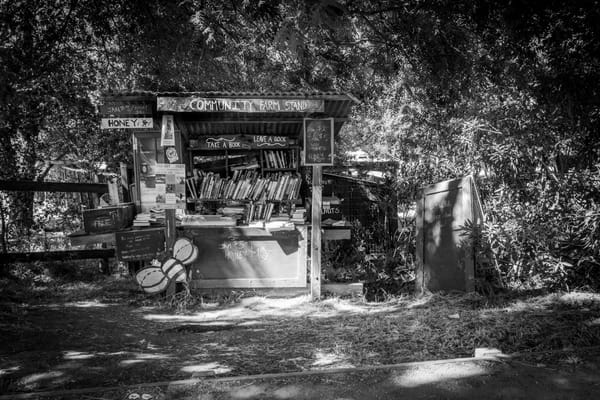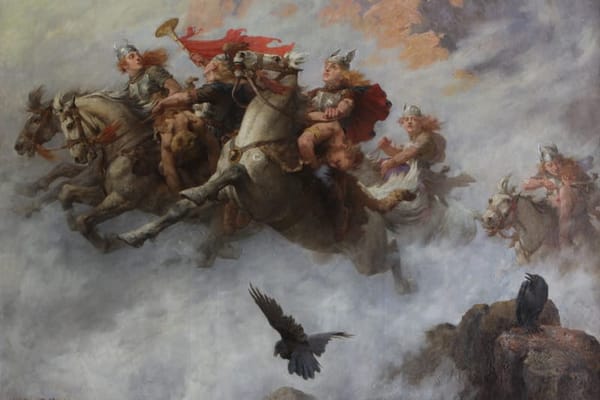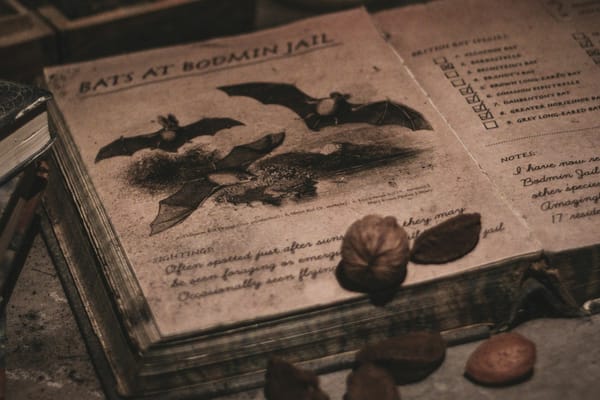"Our visions come from madness and passion and nightmares..."
Steven C. Davis is the creator of ‘The Sælvatici’ series, a dark Pagan, retelling of the Robin Hood mythos. We catch up to find out more...
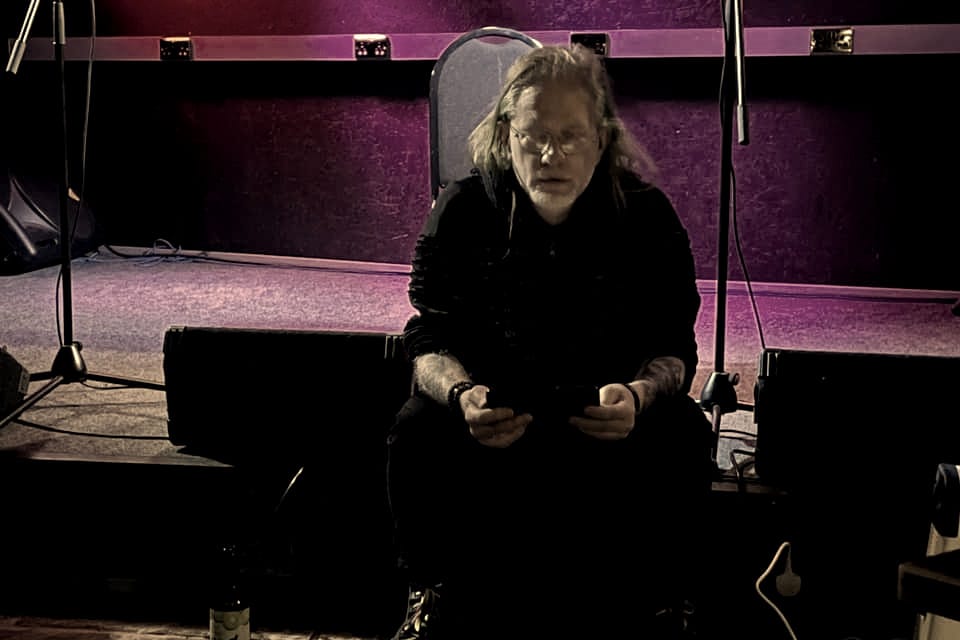
Steven C. Davis is the creator of ‘The Sælvatici’ series, which includes ‘Lore of the Sælvatici’, the ‘Hurnungaz’ trilogy, ‘The Littlest Krampus’, ‘Barrow witch’ and more, and is a folk-horror and mythologically inspired, dark Pagan, retelling of the Robin Hood mythos. They are also the creator and author of the ‘Less than Human’ shape-shifter series, set in the UK.
They are the Creative Director of Tenebrous Texts, a publisher of speculative, alternative and dark fiction and poetry works.
They are also one half of the gothic poetry duo, ‘Poetic Malevolence’, which also features Laura Jane Round.
We catch up with Steven to find out more.
Q: At Tenebrous Texts, you describe your writers as visceral, people whose souls and hearts are too bloody and too raw; whose visions come from madness and passion and nightmares... recycled dead trees call to our unreason, our beauty, our excesses and the siren songs of our darkest passions. What excites you the most when you meet someone you feel shares that same emotion?
A: Partly it’s the potential of where them joining Tenebrous might lead. With Lorna Rose and Laura Liptrot joining Tenebrous (both of them are actors, amongst their many talents) we are exploring the possibility of doing more things of a theatrical nature, and each of them has an event as part of the forthcoming Dudley Writers’ Festival. And with Laura, I’ve started looking at the possibility of a YA imprint of Tenebrous Texts – which will be a fun and incredibly tight line to walk, given the visceral or often dark nature of what we publish. But the future is the next generation, and if we can catch and hook them young with the idea of high quality, independent, alternative writing, then we’ve gained a supporter for life.
Partly it’s the tales they bring – tales that, without Tenebrous, might never see the light of day. Tales that are too quirky for the mainstream, or might be too polished in that process and lose the vital and appealing spark they had. And it makes such a difference to the writers – we’ve got stories being published now that are 10, 15, even 20 years in the conceiving and writing. The effect that has on a writer, a person, to be told, ‘yes, I’ll happily publish this and work with you to get it out there,’ can’t be overemphasised enough. And that in turn leads to book launches and events and the authors get feedback and praise and that’s a confidence builder that feeds back into Tenebrous and so on.
Partly it’s the joy of being able to say ‘yes’ to someone after all the countless big publishing houses many of us have approached and been turned down by. They are out of touch; at Tenebrous we do not accept submissions but instead actively seek out people that we think fit in with our mindset. The author has a level of control that they wouldn’t with a big house; being able to give creatives not just the opportunity to be published as a writer, but to explore other parts of their creativity – I am in such a fortunate position and we’re building something rather special with Tenebrous Texts and all its branches and possibilities.
Q: What books have you published so far in 2025 and what do you enjoy most about the publishing process?
A: In no particular order: ‘Constructing Churchill’, by Jon Hartless, a sublime work of snark, delving into how those in power retain it, despite their incompetence, greed and corruption. ‘Tenebrosian Ekphrasticity’, an anthology of ekphrastic poetry and the art that inspired it. ‘Freshly dipped and bleeding love’, my own debut poetry collection. ‘From Earth and Sky’ by Sadie Kaye, a wonderful work of investigation into Norse myths, retold in poetic stanza. ‘The Green Boy’ by Laura Liptrot, the second in her ‘Garden of Time’ series – imagine Doctor Who, but with romance instead of science. ‘Hurnungaz Dissever me Never’, the third of the ‘Hurnungaz’ trilogy and the fourth in ‘The Sælvatici’ series. And ‘Crown Her With Ivy’, from Lorna Rose, a playscript about Ariadne and Dionysus, which was performed at last year’s Raising Steam Festival and has a couple more performances lined up. And, as of 03.06.25, I’ve just published ‘Seven by Seven’, the seventh in my “Less than Human” series.
What I enjoy most is an author I’m working with getting their book out there, and Tenebrous having another book to their name. Each book expands our audience a little bit, pushes the name a little bit further and opens up untold possibilities. Through Tenebrous Texts I can deliver what large publishing houses can’t or won’t – alternative voices, different types of tales, books that don’t have a budget or sales expectation – books that are written because they’ve been burning holes in the author’s head for a while, books that are passion projects and are so different from what’s already out there.
Q: You describe your own work, ‘The Sælvatici’, as a folk-horror retelling of the Robin Hood mythos. How do you research a figure and a tale that has such a wonderfully meandering provenance in the mists of history, storytelling and legend?
A: I approached the project with a level of detail and atmosphere that I hadn’t applied to any project before. When it is finished – and I suspect I will never actually stop adding to the mythos – there will be (at least) nine books and three of those nine are anthologies, containing 81 short stories set in or around (mainly) the ‘Hurnungaz’ trilogy.
The first task was setting the mood for the preparation. I wanted to put myself in the mindset of what it might be like 1,000 years ago – life was short, cold and brutal. As an outlaw you were constantly on the run and anyone could hunt or kill you. There was no home, no fixed base, no guarantee of even anything to eat or drink each night. Clothes were patched rags and layers – certainly no suits of Lincoln Green tights! You might believe in the Forest god but that was enough to get you killed by the followers of Ullr, Wōden or the Christ of the East. What I was aiming for in the retelling was a level of grim realism not seen elsewhere.
Music was very important for creating the mood – albums by the likes of Heilung, Blind Guardian, Leaves’ Eyes, Apocalypse Orchestra, Duendelirium and others created the perfect backdrop.
I then approached it from the point of view of the characters, and creating the mood and the setting was of paramount importance. I reimagined every character and then the background times and gods before considering any actual tales.
The figure of ‘Little John’ is a perfect example: it’s not even a funny joke the first time it’s said, particularly to a character who is often portrayed as angry. So they would likely have been ‘John of Hathersage’. Except, 1,000 years ago, Hathersage was known as Hereseige. So Hereseige John, or, more often, Hereseige, they became.
I wanted to make The Hooded a potentially fractious group of disparate people, of those worshipping different gods or none. Wōden’s two Ravens – Muna and Hugi – are part of the Hooded, though differently interpreted; Wulfrun of Scarsdale (Will Scarlet) is a follower of Ullr. The character of Brother Blacwin, a believer in the Christ of the East, was added to show that ‘The Christ of the East’ religion was not wholly bad. Tam believes in no god, in nothing beyond death.
Building on what Robin of Sherwood had started, I knew this world would be one full of gods and Hel creatures with traces of Cthulhuism. Herne was obviously out, and Cernunnos, like Robin or Maid Marian, simply too well known or uninspiring to be used. The background became that Sherewode was a battleground for three main gods – Cernunnos, Ullr and Wōden. Except three years before ‘Hurnungaz’ starts, Ullr and Wōden conspire and slay Cernunnos. In that absence, those two gods’ followers gain prominence, as does the new religion, ‘The Christ of the East’.
This creates a nicely unsettled world, where ‘The Christ of the East’ are building a cathedral in the heart of Sherwood to stamp out paganism, the poor, Norse, peasants, anyone they don’t like. The Normans have not long conquered the country and there are the inevitable clashes between the Normans and the Norse, the Anglo-Saxons and the old Ænglish. Justice and history are being stolen or rewritten, tales retold to paint the Normans in a more favourable light.
Into that comes Robin, a minor Anglo-Saxon nobleman, hunting a stag to feed his people. The slaying of the stag creates a transference of power – Sherewode and many of its inhabitants have been crying out for help – and through that act the mad stag-godling Caerne comes into existence. Backlashing from that, Robin becomes Hurnungaz and gains supernatural abilities but loses some of his humanity. Caerne, unlike other forest gods who rely on worship for power, is power personified, but with many questions: who and how is she? Is Cernunnos her father-creator or is it Robin/Hurnungaz? Is it the slain stag? Is she the spirit of Sherewode made tangible? She has power and questions, no answers, and the people who cried out to Cernunnos are still being abused.
Sherewode itself is viewed differently by those within it, and within this recounting, it covers most of the country. To the Normans, the ruling class, those who think themselves well bred, it is Sherwood. To those working on the land, to pagans, Anglo-Saxon peasants and the like, it is Sherewode. Everything I could think of was reinterpreted, changed, approached from a different angle to bring something fresh and different.
I wanted representatives from around the UK, and so from Wales came Brother Bwyd, aka Brother Tuck, though a much younger and slimmer version than is often seen, and also a member of the Sælvatici, forest guardians, of whom Robin had been one prior to being elevated to being a minor lord. From Scotland comes Tam, my own creation, a man whose children were slain by a nobleman, causing Tam to flee for killing their murderer in turn. From Northern Ireland comes the character of Mar, a warrior trained by Scáthach, though now identifying as an assassin after the slaughter of their whole tribe. There is even a character, Alain, who has made their home in London for a while.
Another important aspect for me, in addition to portraying the likely sexual politics of the time, was that the characters would have a range of representations not often openly seen in Robin Hood myths. Mar was born female, had a child, but now identifies as an assassin. Alais presented themselves as their brother, Alain. Iona, despite her troubled background, soon moves into a poly-relationship.
The main arc of the trilogy is the construction of what appears, at first, to simply be a cathedral to the Christ of the East in the heart of Sherewode. However, it is later revealed that it will be a city, intended to salt and burn the earth, destroying trees, paganism, the old way of life, everything that doesn’t fit in with The Christ of the East or with Norman attitudes.
In the second book, ‘Hurnungaz the Dark Breath of Earth’, the underlying arc is the arrival of Diederic and Angenijs from an unknown place. Using ‘The Children of the Woolpit’ or ‘The Green Children’ as a pattern, their journey to find somewhere to call home runs parallel to the conflict between the outlaws and the Sheriff and his forces.
In the third book of the trilogy, ‘Hurnungaz Dissever me Never’, the focus shifts to Iona and a group of storytellers, crisscrossing Sherewode, telling tales of the Hooded. With increasing signs of a final battle with the Sheriff being imminent for the Hooded, I posed the question – who is more of a threat to the establishment – those who defy them, or those who spread tales of that defiance?
An early decision was the relevance of the tales. There had to be points where the situation was in parallel with current times. In 1,000 years, not much has actually changed. The Normans were in power, stealing and changing justice, history and religion to suit them. They clamped down extra hard on anyone they could, on anyone who might challenge them.
With all that set up, presenting a radically different and darker Robin Hood tale, it was then time to look at the novels themselves, and an early decision was for there to be no chapter breaks, for all three books to simply be a single tapestry of a tale of a Robin Hood character that would predate all other versions. Put another way, imagine the ‘Hurnungaz’ tales being rewritten over the centuries, with Romantic reinterpretations, Hollywood interpretations, Disney interpretations – and then lost to time, scrolls lost in a shepherd’s hut in Rievaulx in Yorkshire, awaiting discovery and translation.
The three novels run to 250,000 words; some 180,000 or thereabouts were written in 2023, with all other projects put to one side. It was about working out what the characters would do, which became easier the more about them I wrote, and what would challenge them. Adding in familiar tropes – hunting deer, outwitting the Sheriff, resisting the Normans etc – to push the story along where needed. It probably still is the best thing I have ever written: it was always one tapestry rather than three novels. Characters and conflict were piled in to create a world where anything is possible – ‘Lore of the Sælvatici’ contains a short story version of the song ‘The Twa Corbies’ and other songs have been written in, from folk-rock songs interpreted by Steeleye Span to aggro/dark industrial tracks (‘Verrtrandt’) and more.
With all that, I had my world, my characters, and their backgrounds and story arcs, as well as the arcs of the “forces of authority”, gods, Hel beasts and other instances. It practically wrote itself after that! The very first short story ever written for the world, ‘Rise of the Sælvatici’, was a mere 2,000 words. I rewrote it for the latter part of ‘Hurnungaz Dissever me Never’ and it came in around 20,000 words. Like all good myth cycles, there are different versions of events and conflicting stories and characters.
Q: What are you working on now and what’s the next book we can expect from you?
A: Currently I’m working on ‘The Bookshop Between the Worlds’, which takes my debut novel, ‘Cornix Sinistra’, adds the unpublished follow on, ‘Armageddon Angel’ and conflates them with some additional stories being written at the moment. I’m hoping to get that out towards the end of 2025. It’s an alternate-reality tale, set around a bookshop in Reading.
I’ve just started plotting the next novel in The Sælvatici series. It’ll likely be of a more Celtic feel, concentrating on the mad stag-godling, Caerne. I’ve got several months, at least, of reading and investigating Scottish myths and legends, particularly around the ideas of Seelie and Unseelie Courts, and I’m really looking forwards to that, having been into Celtic mythology all my life.
Coming up next from me is ‘Seven by Seven’, the seventh in the ‘Less than Human’ series, which is officially launching in June 25, and the one after that, ‘Feral Dreaming’, which will be out in July/August. ‘Feral Dreaming’ is vaguely autobiographic, as well as being a spiritual quest type thing, going back and revisiting something that happened to a younger version of me. It also has my spirit guide and some of the characters from the ‘Hurnungaz’ novels in it and is a kind of statement of intent re creativity. After the ‘Hurnungaz’ tales, it was a very fun thing to write!
Q: Where is your favourite place to write and create? Is it somewhere by yourself or do you like to be with other people? What do you enjoy most about collaborating with the creative people in your community?
A: Most of my writing gets done at the PC, sat with my back to the garden. Creating, however, happens everywhere and anywhere. I like films and TV series for presenting ideas and being able to transpose them into alternative worlds – something from the third Riddick film has inspired a stand-alone Sælvatici tale – once you strip away the trappings, it’s all about the emotion you can create in a reader/ watcher, and that transcends genre.
For the ‘Less than Human’ series, there’s a little nature reserve not far from me, a wooded haven surrounding a lake and surrounded by canals and industrial units which seems the perfect place to hash out plot lines and ideas.
Collaborations can be such fun and rewarding!
It is so much fun working with Laura Jane Round as ‘Poetic Malevolence’ in the performance poetry scene – people still talk about our debut performance back in 2023 and how electrifying it was. We’ve got a debut album that’s 2/3rds recorded, so I’m looking forwards to that being available at some point.
I’ve got a part in a Sherlock Holmes adaption, ‘The Haunting of Baker Street’, that’s just started being filmed – to go to the writer/director and go ‘I think my character would do this because … and that could then give them this back story’ and have them go ‘yes. Wow! That really works well I like that idea’ it’s just – indescribable. Working creatively in collaboration can really lift everyone involved and create something beyond the sum of the parts. And that’s just fantastic, to draw the very best out of our community.
Q: As well as publishing the written word, you also work on podcasts, audiobooks, radio plays, music, painting… what do you enjoy the most about each form?
A: Each appeals to a different part of me. I’ve just started the idea within Tenebrous of having sessions to record short clips from our books so we have something for social media – and sometimes what an author writes can be delivered better by someone who’s not the author. To hear one author reading another author’s work – it has to be thought about carefully, but when it works, it elevates both/all parties.
It was always my intention that anything I write, but particularly ‘The Sælvatici’, would be multi-media. To be able to create short films, audio clips, podcasts – ‘Lore of the Sælvatici’ has a whole podcast related to it on Mixcloud – it’s another way to bring it to people’s attention and another way to express myself.
A friend gave me a free voucher to one of these ‘painting and prosecco’ kind of evenings. That led to me starting painting with acrylics; I don’t particularly want to use it for covers or anything, but I am quite happy to share them on fb so people can see creativity doesn’t have to be perfect, it doesn’t have to be flawless – creativity can just be for the sake of itself. And in a nice, and unplanned, turnaround, some of my art is in ‘Tenebrosian Ekphrasticity’ alongside far better artists (Jason Fullwood and Al Monde). Which is nice. And slightly humbling.
Q: If there was a different era in history you could go to, when would it be? And why?
A: I like the idea of retiring to Nepal to teach English in a mountain village. It wouldn’t even particularly need to be a different era. But if we’re talking a different era, then I like the idea of being a Visigoth and sacking Rome. Because it’d be nice to let my destructive side off the leash for a while.
Q: Is there a novel you’d love to write if you had infinite time available?
A: There was an intended series of five novels that I’ve had to abandon because I’ve lost touch with the co-author of them. There was another potential, which at the moment is a single short story of a post-fantasy type thing, which I might revisit if I have time. At the time of writing that short story I had six or seven different series I was working on, so something had to give. I’m down to four series with one waiting in the wings.
In terms of a single novel I’d like to write … I did actually start working on one a couple of years ago. It would be set after all the series were complete and finished and feature at least a single character from each of the series. Quite meta and fourth-wall breaking, but it might be fun having some of the characters describing what I put them through and their thoughts on that and on me. I don’t think some of them would be over-impressed!
I wrote a stand-alone novel, ‘Feral Dreaming’, and that in turn has inspired another, riffing off the concepts within it but going in a different direction. ‘Feral Dreaming’ hadn’t been planned, it sprang into existence whilst I was editing an MS from Nimue Brown. So I don’t have a specific novel I’d love to write, but I love the fact that one novel can inspire another, totally different, and I’d love to create a chain of “this stand-alone book inspired that one, and that one in turn inspired...” and so on.
Q: What short story ideas are you working on for future Harveys, and which basket excites you the most?
A: I tend not to look too far ahead with the Harveys; at the moment I’m busy publishing and working on my own projects, but I definitely want to submit to more of the Flash!Mobs. I had such fun with the Deep Roots tale, and The Cat’s Whiskers I’m hoping to write and submit something for. And Dark Urban Fantasy is kinda in my ballpark, if I can think of a standalone tale to fit in, that could be fun.
Q: What advice would you give anyone starting out on their writing and publishing adventure?
A: The best advice I can give is write as much as you can, as widely as you can. Even if you feel you only want to write SF, for example, learning the rules of poetry can still help. Take advantage of every writing course or class you can get to – I was very lucky to be able to take one held by Brian Stableford, and from him I picked up the notion of starting as close to the end as possible. From another I learned full use of the senses – don’t just show us what the character can see; what can they hear? What can they feel beneath their hand? What can they smell? Place us fully in the world you’ve created – don’t bother with giving us all the back story and set up, drop us into it and take us into the action. Let us see your world through the character’s senses – if they don’t or wouldn’t know something, don’t tell us.
In terms of publishing, I would take it slow and careful. Once you’ve got the finished product in your hand, you’ll then do your best editing. And the advantage of some sites you might use is you can resubmit the MS and redo the cover as often as you need to. I was three or four books into the “Less than Human” series before I realised that I had a character who was sometimes named Kelly and sometimes named Kerry. If you’re intending to create and write a series, a bible/guide to it for yourself is an absolute must. Whilst writing the 8th of the “Less than Human” series, I had to investigate several other books of the series to find out if the viewpoint character’s partner’s mother had been told that Nat was a shape-shifter. It’s a little thing, but if you get it wrong …
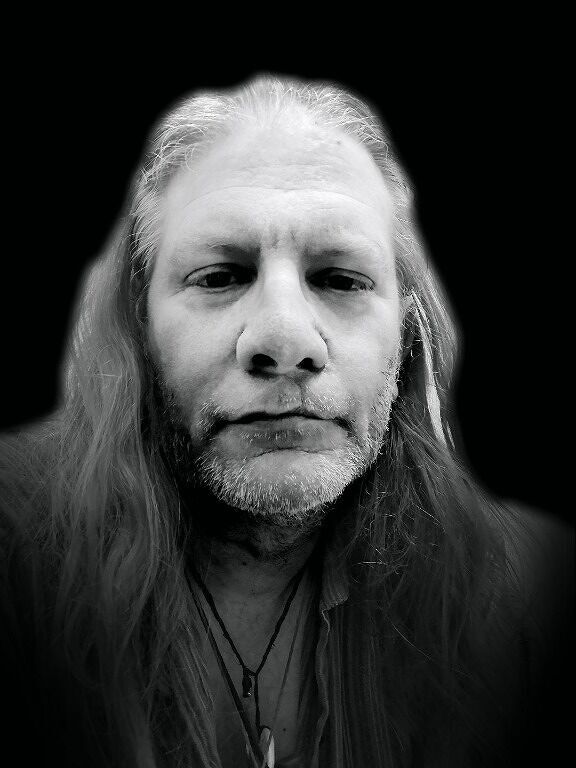
Find out more at: https://www.facebook.com/TenebrousTexts/

